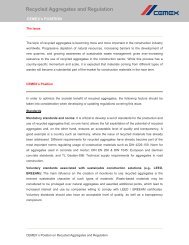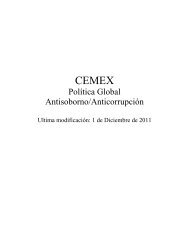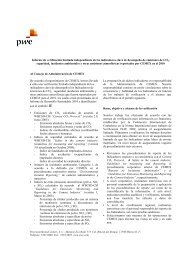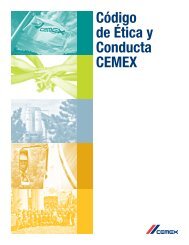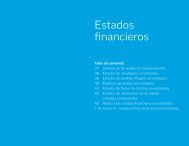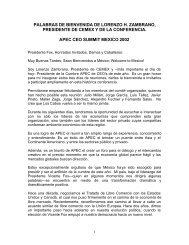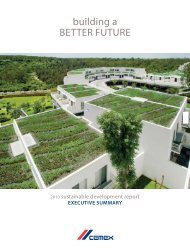building a STRONGER foundation - Cemex
building a STRONGER foundation - Cemex
building a STRONGER foundation - Cemex
Create successful ePaper yourself
Turn your PDF publications into a flip-book with our unique Google optimized e-Paper software.
CEMEX, S.A.B. DE C.V. AND SUBSIDIARIES<br />
Notes to the Consolidated Financial Statements – (Continued)<br />
As of December 31, 2010, 2009 and 2008<br />
(Millions of Mexican pesos)<br />
In order to neutralize those positions and considering contractual limitations to settle the contracts before their maturity date, in October 2008,<br />
CEMEX entered into new derivative instruments with the same counterparties, which represented the opposite position to the exposure<br />
resulting from fluctuations of the economic variables included in the original derivative instruments. As a result, from the date of the<br />
negotiation of the new opposite positions, any changes in the fair value of the original instruments has been effectively offset by an equivalent<br />
inverse amount generated by the new positions. The derivative instruments still exposed to changes in fair value were designated as “Active<br />
derivative financial instruments.” In addition, CEMEX designated the portfolio of original and opposite derivative positions as “Inactive<br />
derivative financial instruments.”<br />
During April 2009, following negotiations with its creditors, CEMEX completed the settlement of a significant portion of its active and<br />
inactive derivative financial instruments held at the beginning of the year in order to reduce the risk of further margin calls. By means of this<br />
settlement, CEMEX recognized in 2009 an aggregate loss of approximately US$1,093, which after netting US$624 of cash margin deposits<br />
already posted in favor of CEMEX’s counterparties and cash payments of approximately US$48, was documented through promissory notes<br />
for approximately US$421, which increased CEMEX’s outstanding debt. Previously, in February 2009, CEMEX and its counterparties agreed<br />
the settlement of a portion of the obligations incurred through derivative instruments. The counterparties permanently withdrew part of the<br />
amounts deposited in such margin accounts at the beginning of the year for an amount of approximately US$392, of which approximately<br />
US$102 referred to active positions and approximately US$290 referred to inactive positions.<br />
As mentioned above, all Cross Currency Swaps (“CCS”) outstanding at the beginning of 2009 were settled in April 2009. In 2009 and 2008,<br />
changes in the fair value of CCS generated losses of approximately US$61 (Ps830) and US$216 (Ps2,421), respectively.<br />
As previously mentioned, all outstanding foreign exchange forward contracts at the beginning of 2009 were settled in April 2009. Until<br />
October 2008, in order to hedge financial risks associated with fluctuations in foreign exchange rates of certain net investments in foreign<br />
countries denominated in euros and dollars to the peso, and consequently, reducing volatility in the value of stockholders’ equity in<br />
CEMEX’s reporting currency, CEMEX negotiated foreign exchange forward contracts with different maturities until 2010. Changes in the<br />
estimated fair value of these instruments were recorded in stockholders’ equity as part of the foreign currency translation effect. The<br />
designation of the original positions as hedges of CEMEX’s net exposure on investments in foreign subsidiaries in stockholders’ equity<br />
terminated with the negotiation of the opposite derivative positions in October 2008. Therefore, changes in fair value of original positions and<br />
opposite derivative positions were recognized prospectively in the statement of operations. Valuation effects were recognized within<br />
stockholders’ equity until the hedge designation was revoked, adjusting the cumulative effect for translation of foreign subsidiaries.<br />
On July 15, 2009, in connection with the derivative financial instruments associated with CEMEX’s perpetual debentures (note 16D), by<br />
means of which the Company changed the risk profile of the interest rates and the currencies of the debentures from the U.S. dollar and the<br />
euro to the yen; and in order to eliminate CEMEX’s exposure to the yen and the yen interest rate, CEMEX concluded the settlement of its yen<br />
cross currency swap derivatives, as well as the forward contracts for US$196 as of December 2008, negotiated to eliminate the variability of<br />
cash flows in yen to be incurred through the CCS until 2010, in which CEMEX received cash flows in yen and paid U.S. dollars. As a result,<br />
a total amount of approximately US$94 was invested with trustees for the benefit of the debenture holders. This amount is being used to pay<br />
CEMEX’s coupons on the perpetual debentures. As a result of this settlement, during 2009, CEMEX recognized a loss from changes in the<br />
fair value of the instruments of approximately US$162 (Ps2,203). As of December 31, 2010 and 2009, the balance of the investment placed in<br />
the trusts amounted to approximately Ps902 and Ps1,011, respectively.<br />
The estimated fair value of derivative instruments fluctuates over time and is determined by measuring the effect of future relevant economic<br />
variables according to the yield curves shown in the market as of the reporting date. These values should be analyzed in relation to the fair values<br />
of the underlying transactions and as part of CEMEX’s overall exposure attributable to fluctuations in interest rates and foreign exchange<br />
rates. The notional amounts of derivative instruments do not represent amounts exchanged by the parties, and consequently, there is no direct<br />
measure of CEMEX’s exposure to the use of these derivatives. The amounts exchanged are determined based on the basis of the notional<br />
amounts and other terms included in the derivative instruments.<br />
I. Interest rate swap contracts<br />
As mentioned above, all outstanding interest rate swaps related to debt at the beginning of 2009 were settled in April 2009. Changes in fair<br />
value of interest rate swaps, including the swap described in the following paragraph, generated a gain of approximately US$9 (Ps114) in<br />
2010, and losses of approximately US$2 (Ps27) in 2009 and US$170 (Ps1,906) in 2008.<br />
As of December 31, 2010 and 2009, CEMEX had an interest rate swap maturing in September 2022 with notional amounts of US$196 and<br />
US$202, respectively, negotiated to exchange floating for fixed rates in connection with agreements entered into by CEMEX for the<br />
acquisition of electric energy in Mexico (note 19C). As of December 31, 2010 and 2009, the fair value of the swap represented gains of<br />
approximately US$35 and US$27, respectively. Pursuant to this instrument, during the tenure of the swap and based on its notional amount,<br />
CEMEX will receive a fixed rate of 5.4% and will pay a LIBO rate, which is the international reference for debt denominated in U.S. dollars.<br />
As of December 31, 2010 and 2009, LIBOR was 0.46% and 0.43%, respectively. Changes in the fair value of this instrument generated a gain<br />
of approximately US$9 (Ps114) in 2010, a loss of approximately US$27 (Ps367) in 2009 and a gain of approximately US$36 (Ps404) in 2008.<br />
F-39



